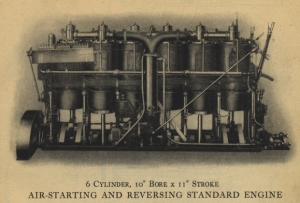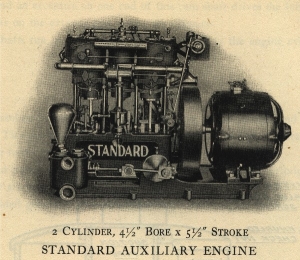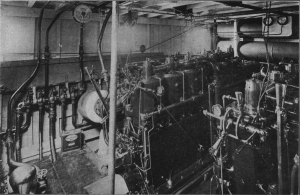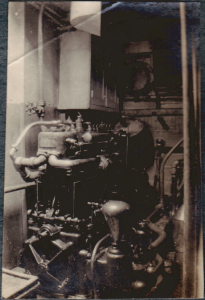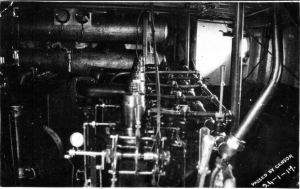The Main and Auxiliary Engines
The following mechanical information is taken from Nutting's The Cinderellas of the Fleet pretty much verbatim.
The following mechanical information is taken from Nutting's The Cinderellas of the Fleet pretty much verbatim.
The power plant consists of a twin screw installation of two 6-cylinder, 4-cycle air-starting and reversing motors having cylinders 10 in. bore by 11 in. stroke, build by the Standard Motor Construction Co., of Jersey City, N.J. These motors, which are rated by the builder at 220 hp. at 400 r.p.m., are directly connected to the three-bladed propellers, 42-in. diameter by 63-in. pitch.
An auxiliary set, also made by the Standard Motor Construction Co., includes an air compressor, a 4-1/2-kw. generator and a bilge and fire pump. The total capacity of the tanks is 2100 gal., giving a radius of action of 750 nautical miles at 19 knots and 1000 nautical miles at 15 knots.
An auxiliary set, also made by the Standard Motor Construction Co., includes an air compressor, a 4-1/2-kw. generator and a bilge and fire pump. The total capacity of the tanks is 2100 gal., giving a radius of action of 750 nautical miles at 19 knots and 1000 nautical miles at 15 knots.
The maximum speed obtained on trial varied on the different boats from about 19-1/4 knots to almost 21 knots.
In The Dover Patrol Admiral Bacon notes that early on the ML's had very noisy exhausts—"enough to frighten a submarine miles off." And the engine room ventilators were situated so that they discharged right around the captain and helmsman which must not have been very pleasant.
In The Dover Patrol Admiral Bacon notes that early on the ML's had very noisy exhausts—"enough to frighten a submarine miles off." And the engine room ventilators were situated so that they discharged right around the captain and helmsman which must not have been very pleasant.
